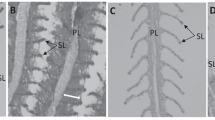Abstract
Model ecosystems, simulating a Baltic Sea littoral habitat, were used for evaluating the effects of different effluents from kraft pulp mill industries on fish. Populations of newly hatched three-spined stickleback (Gasterosteus aculeatus) were continuously exposed to four different types of pulp mill effluents in a flowthrough sea water system. After 51/2 months of exposure, the sticklebacks were collected for a skin parasite count and histological examination of the gills and liver. The frequencies of two types of skin-dwelling ciliates of the generaTrichodina andApiosoma were higher in the exposed fish populations, particularly in those exposed to the high effluent doses (diluted 400 times). Anomalies in the liver cell structure were observed as necrotic cells, nuclear pyknosis, vacuolation, and fat accumulation. The two effluents from the factories producing unbleached softwood and bleached hardwood without oxygen pre-bleaching affected the sticklebacks most, both in respect to ciliate abundance and to liver anomalies.
Similar content being viewed by others
References
Andersson T (1987) Sublethal physiological effects of pulp and paper mill effluents on fish. A literature review. Swedish Environmental Protection Board Report 3366
Andersson T, Förlin L, Härdig J, Larsson A (1988) Physiological disturbances in fish living in coastal water polluted with bleached kraft pulp mill effluents. Can J Fish Aquat Sci Vol 45,9:1525–1536
Anonymous (1982) SSVL. Swedish Forest Industries' Water and Air Pollution Research Foundation. Environmentally Harmonized Production of Bleached Pulp. Final report. (In Swedish) (Can be ordered from ÅF-IPK, Box 8309, S-10420 Stockholm, Sweden)
Bengtsson B-E, Bengtsson A, Tjärnlund U (1988) Effects of pulp mill effluents on vertebrae of Fourhorn sculpin,Myxocephalus quadricornis, Bleak,Alburnus alburnus, and Perch,Perca fluviatilis. Arch Environ Contam Toxicol 17:789–797
Bruynesteyn A, Waiden CC (1973) Effects of condensates on the toxicity of craft pulp mill effluent. Div of Appl Biol, BC Research, Vancouver 8, BC, Canada
Chinery M (1973) A field guide to the insects of Britain and Northern Europe. William Collins Sons & Co. Ltd, London
Couillard CM, Berman RA, Panisset JC (1988) Histopathology of rainbow trout exposed to bleached kraft pulp mill effluent. Arch Environ Contam Toxicol 17:319–323
Fujiya M (1961) Effects of kraft pulp mill wastes on fish.W P C F Vol 33, No. 9
Haider G (1964) Monographie der Familie Urceolariidae (Ciliata, Peritrichida Mobilia). Parasitologische Schriftenreihe. Heft 17. VEB Gustav Fisher Verlag, Jena
Härdig J, Andersson T, Bengtsson B-E, Förlin L, Larsson A (1988) Long-term effects of kraft mill effluents on red and white blood cell status, ion balance, and vertebral structure in fish. Ecotoxicol Environ Saf 15:96–106
Hemming J, Holmbom B, Järnström S, Vuorinen K (1984) A method for total organic chlorine determination in bleach plant recipient waters. Chemosphere 4:513–520
Hoffman GL (1978) Ciliates of freshwater fishes. In: Krier (ed) Parasitic protozoa II. 589–597. Academic Press, NY
Holmbom B, Lehtinen K-J (1980) Acute toxicity to fish of kraft pulp mill waste waters. Paper ja puu-Papper och trä. No. 11
Khan RA (1990) Parasitism in marine fish after chronic exposure to petroleum hydrocarbons in laboratory and to the Exxon Valdez oil spill. Bull Environ Contam Toxicol 44:759–763
Khan RA, Kiceniuk JW (1988) Effect of petroleum aromatic hydrocarbons on monogeneids parasitizing Atlantic cod,Gadus morhua L. Bull Environ Contam Toxicol 41:94–100
Khan RA, Thulin J (1991) Influence of pollution on parasites of aquatic animals. In: Advances in parasitology, Academic Press Ltd, Vol 30, pp 201–238
Lindén O, Rosemarin A, Lindskog A, Höglund C, Johansson S (1987) Effects of oil and oil dispersants on an enclosed marine ecosystem. Environ Sci Technol 21:374–382
Lom J (1965) Ciliates from the surface of fishes and factors influencing their occurrence. In: Progress in Protozoology. Abstract papers read at the second international conference on protozoology. London 29th July–5th August. International Congress Series. 91:247–8
— (1973a) The adhesive disc ofTrichodinella epizootica-ultrastructure and injury to the host-tissue. Folia Parasitologica (Praha) No 20:193–202
— (1973b) The mode of attachment and relation to the host inApiosoma picicola Blanchard andEpistylis lwoffi Faure-Fremiet, ectocomensals of freshwater fish. Folia Parasitologica (Praha) 20:115–112
— (1984) Diseases caused by protistans. In: Kinne O (ed) Diseases of marine animals. Biologishe Anstalt Helgoland, Hamburg. Vol IV, part I, pp 157–165
Notini M, Nagell B, Hagström A, Grahn O (1977) An outdoor model simulating a Baltic Sea littoral ecosystem. Oikos 28:2–9
Renberg L (1981) Gas Chromatographic determination of phenolic compounds in water, as their pentafluorobenzoyl derivatives. Chemosphere 10(7):767–773
Romeis B (1968) Mikroskopische Technik. R Oldenburg Verlag, München, Wien
Rosemarin A, Lehtinen K-J, Notini M (1990) Effects of treated and untreated softwood pulp mill effluents on Baltic Sea algae and invertebrates. Nordic Pulp Paper Res J 2:83–87
Rosemarin A, Mattson J, Lehtinen KJ, Notini M, Nylén E (1986) Effects of pulp mill chlorate (C1O −3 ) onFucus vesiculosus — A summary of projects. Ophelia 4:219–224
Södergren A (ed) (1988) Biological effects of bleached pulp mill effluents. National Swedish Environmental Protection Board. Report 3558
Södergren A, Bengtsson B-E, Johnsson P, Lagergren S, Larsson Å, Olsson M, Renberg L (1988) Summary of results from the Swedish project Environment/Cellulose. Wat Sci Technol, 20. 1:49–60
Voss R, Rapsomatiotis A (1985) An improved solvent-extraction method for the gas Chromatographic analysis of resin and fatty acids in pulp mill effluents. J Chromatogr 346:205–214
Wong A, Le Bourhis M, Wostradowski R, Prahacs S (1978) Toxicity, BOD and color of effluents from novel bleaching processes. Pulp Paper Can 7:41–47
Author information
Authors and Affiliations
Rights and permissions
About this article
Cite this article
Axelsson, B., Norrgren, L. Parasite frequency and liver anomalies in three-spined stickleback,Gasterosteus aculeatus (L.), after long-term exposure to pulp mill effluents in marine mesocosms. Arch. Environ. Contam. Toxicol. 21, 505–513 (1991). https://doi.org/10.1007/BF01183871
Received:
Revised:
Issue Date:
DOI: https://doi.org/10.1007/BF01183871




